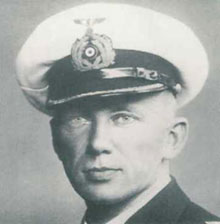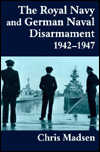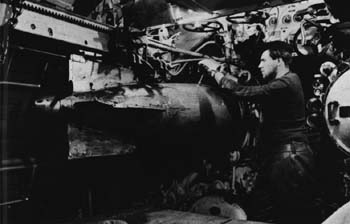Read this great article on the massive German torpedo malfunctions during the war and the missed chances they resulted in.
| Type | Propulsion | Range/Speed |
| G7a | T1 | Compressed air (wet heater) |
6000m/44kts 8000m/40kts 14000m/30kts |
The pre-war issue torpedo, it had the disadvantage of leaving a visible trail of bubbles on the surface on its way to the target.
| G7e | T2 | Electric | 5000m/30kts * |
The standard torpedo of the war. It suffered from early problems with its internal depth-keeping equipment, and its firing pistol, but these were solved after the Norwegian Campaign.
In mid 1942 an improved version was introduced with an icreased battery capacity. The increased battery capacity increased the range 50%. The improved G7e was designated T3a. Range was 7500m at 30 knots (preheated state - 4500m at 28 knots).
* data for preheated state. Full effectiveness was obtained when the T2 was preheated electrically to 30 degrees Cent (86 F) before firing. Not preheated figures are 28 knots for 3000m.
| T3 | Electric | 5000m/30kts |
As for T2 but fitted with an influence fuse.
| T4 | Electric | 7500m/20kts |
Falke, the first homing torpedo, was fitted with a passive acoustic homing device. It was introduced in March, 1943 and used by U-603 (Oblt. Bertelsmann), U-758 (Kptlt. Manseck) and U-221 (Kptlt. Trojer) against convoys HX-229 and SC-122. Few were used as it was replace by the T5 which was faster, had a greater range and could be used with either magnetic or contact detonators.
| G7s | T5 | Electric | 5700m/24kts |
The Zaunköning (Wren) came into service during the autumn of 1943. Intended to be an escort-killer, it achieved some early minor success only to be countered by the allied Foxer noise-making decoy. It was scoring hits against escort and merchants to the end of the war though.
The weapon was designed to lock onto the loudest noise after a run of 400m from its launch. This often proved to be the U-boat itself and standard issue-orders were to dive immediately to depth of 60m after launch froma bow tube while a stern shot was to be followed by a complete silence in the boat. Two U-boats were almost certainly lost when hit by one of their own T5 torpedoes, U-972 in Dec 1943 and U-377 in Jan 1944.
| T11 | Electric | 5700m/24kts |
A modified T5, less affected by Foxer. Never used in battle conditions although late test results were promising.
Variants
All the German U-boat torpedoes were 53.3cm (21 inch) in diameter and had a warhead of 280kg (The T5 had 274kg). There were also two important pattern-running devices which could be applied to various torpedo types. These were FAT and LUT.
The FAT (Federapparat Torpedo) ran a wandering course with regular 180-degree turns, was useful against convoys, and was fitted to both G7a and G7e T3s. From the end of 1942 onwards it was manufactured at the rate of roughly 100 per month.
LUT was a more sophisticated version of the FAT, with more variable patterns, but was only used operationally towards the end of the war.




